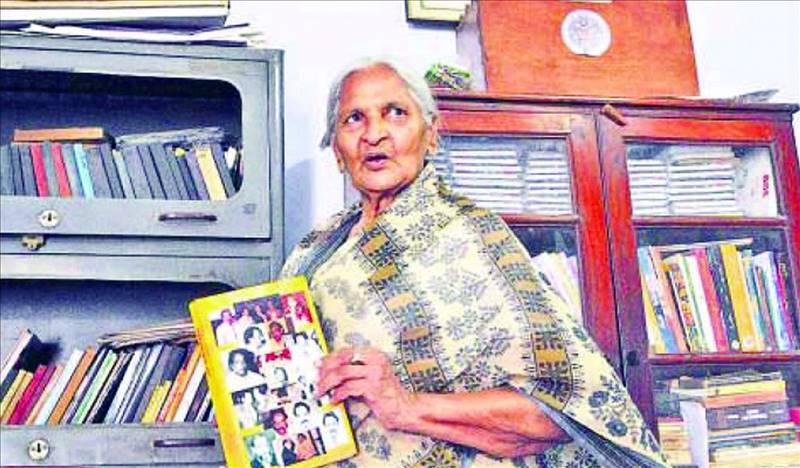
While the South Asian literary world reacted to the decision of the German city of Dortmund to revoke the award of the prestigious Nelly Sachs Prize to British-Pakistani writer Kamila Shamsie last week, Begum Masroor Jahan quietly slipped into literary immortality in her beloved Lucknow on Sunday the 22nd of September at the age of 81. Hers was an astonishing legacy of some 65 best-selling novels and more than 500 short-stories. In fact, the news of the passing away of this legendary titan sadly could not even make it to the leading Urdu publications in this country – let alone English and other languages. This scribe himself learned about her death a couple of days later on the 24th of September, courtesy the Facebook page of a literary page managed from India, Urdu Classic.
Masroor Jahan belonged to that remarkable generation of Urdu women writers, born between 1925 and 1940, which includes novelists Nisar Aziz Butt, Altaf Fatima, Jilani Bano and Khalida Husain; and short story writers Wajida Tabassum, along with the aforementioned Bano and Husain. With her passing, now only the last two living representatives of that generation remain, Butt from Pakistan and Bano from India (two of whom, namely Fatima and Husain died in the last couple of years)
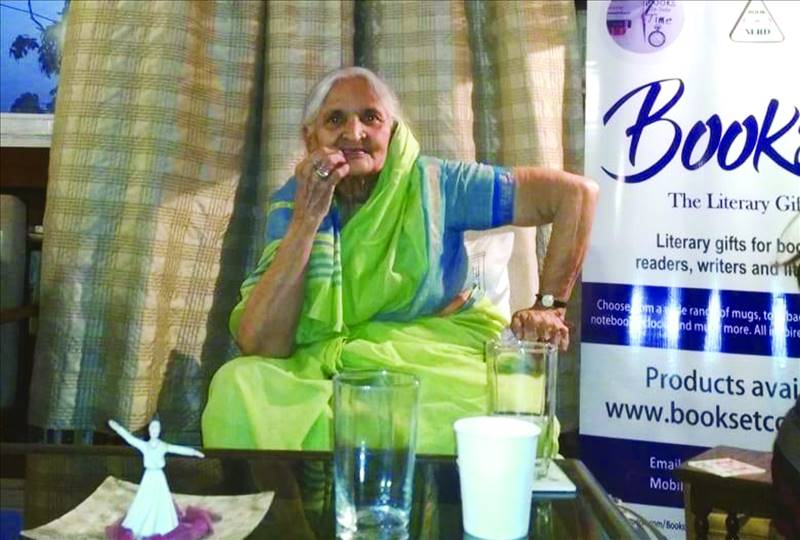
Masroor Jahan was born on July 8, 1938 in an educated and literary household in Lucknow. Her father Professor Sheikh Hussein Khayal Lakhnavi M.A. was a good poet. Her paternal grandfather Professor Sheikh Mehdi Hasan Nasiri Lakhnavi M.A. had a collection of poems to his credit and was also the author and translator of many books. Masroor Jahan had a passion for reading stories from an early age. Along with reading. She emerged with a taste for writing, and had in fact started doing so when she was 7 years old. Her first short-story Who Kon Thi? (Who Was She?) was published in 1960 in the journal Qaumi Aavaaz from Lucknow and then her stories and novels subsequently began to be published in various journals of India and Pakistan. In fact in 1962, just two years after her first short-story, her first novel Faisla (Decision) was published from Pakistan (some say it was Rubina but that is for literary historians and critics to verify). She wrote 65 novels and began writing using the pen-name of Masroor Khayal – among others – which she later changed to Masroor Jahan at the advice of her publisher. She won the prestigious Urdu Akademi Award for 2009-2010 and her stories were also broadcast on Delhi’s Urdu Service.
From her paternal side, her milieu was feudal, while her father was a teacher and the domestic atmosphere was middle-class. She was married off at the tender age of 16 to Nawab Syed Murtaza Ali Khan. Due to this background, her short-stories portray the minds and everyday matters of all these three classes.
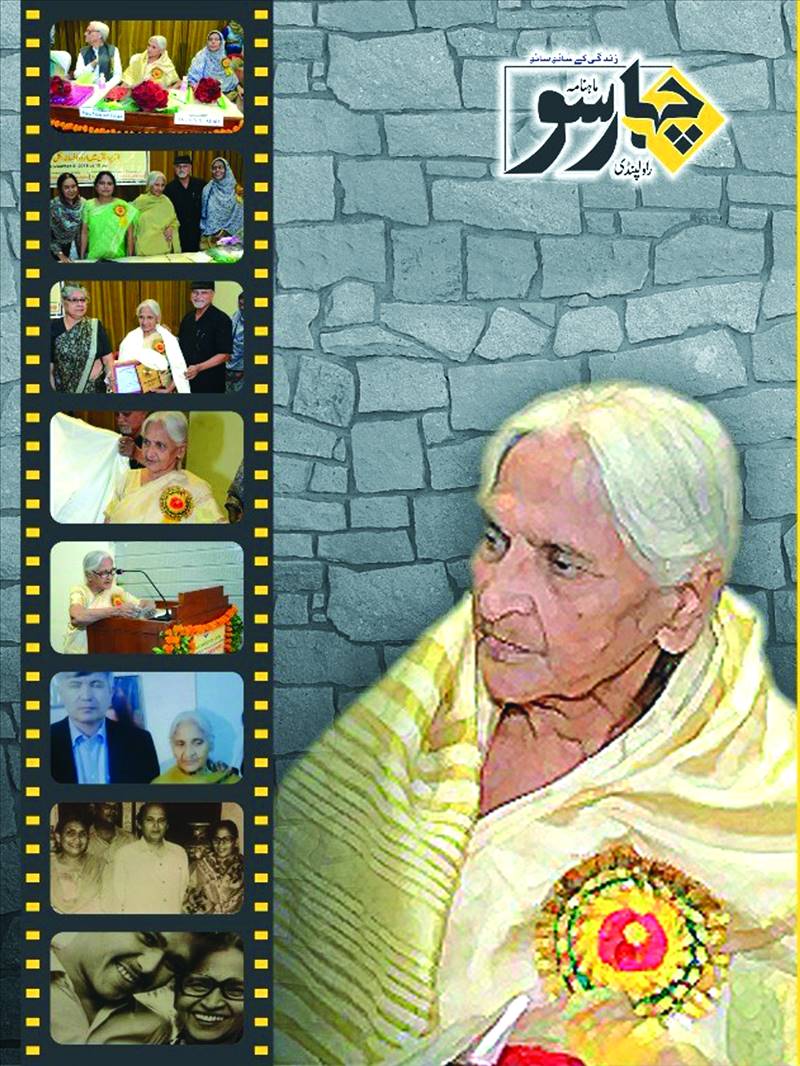
She claimed that whatever she wrote was given to her by her personal experience and observation, not fictitious stories. In a few instances, she even mentioned the real names of people living with her in her novels and when asked about this, the response was immediate: that she did not fear those people ever going to the courts – thus proving that our fiction is not distant from the realities of life.
Her writings were popular with not only the older woman sitting at home, but also the student studying at university. Her stories published in the Urdu journals Beesveen Sadddi and Hareem had a seminal role in the training of middle-class young women of Lucknow. One of the standards of literary success is also that they be read and liked by every class of society. In that respect, many of her novels went into multiple editions. She belonged to a generation of writers who used to publish a novel literally every month; indeed Masroor Jahan’s novels had a huge demand from publishers, so she was forced to publish a novel every month.
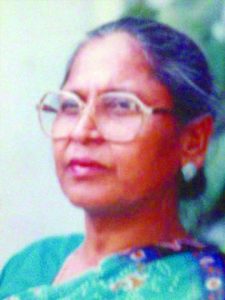
Though Masroor Jahan’s special field was novel-writing, since the last few years she had turned her attention to short-stories. And it can be said with total authority that the real form of her art had indeed manifested in her short-stories. The simplicity of her story, extremely easy language, popular manner of writing and easy imagination were the qualities that distinguished her from her contemporaries, including her fellow-Lucknowite, the late Naiyer Masud, who passed away in 2017, and the late Altaf Fatima, who hailed from Lucknow and passed away in Lahore last year.
Masroor Jahan’s name belongs amongst writers like Rashid Jahan, Ismat Chughtai, Quratulain Hyder, Hajra Masroor, Khadija Mastoor, Razia Sajjad Zaheer, Sarla Devi, Saleha Abid Hussain, Bano Qudsia, Jamila Hashmi, Zaheda Hina to Jilani Bano who through their short-stories and novels drew attention to the woman who is present somewhere in society in some form. Masroor Jahan witnessed the era of the Progressive Movement as well as that of modernism, post-modernism and other trends in literature, but she did not attach herself to any movement or trend. She kept writing in her own style that which was the foundation of her art. There were many topics in her short-stories from the lost cultural bonds to the problems of the present, which are prevalent in this society. Without any complexity of narrative, she filled her stories with such colours of life, which made her stories an example of creative thought, legend, reality and singularity of effect.
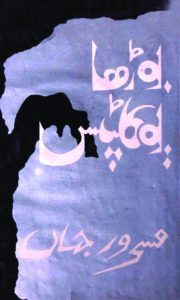 Masroor Jahan gave importance to women and their problems in her stories. These topics had been there in the Urdu afsana even before her. But while presenting these topics, she did not adopt the manner which was particular to some female fiction writers; neither did she adopt the boldness which tramples upon cultural values in the heat of realism. Whether her topics consist of middle-class or lower-class women, or the Anjuman Aras being nourished in high palaces, or the educated woman of the new society, she always maintained a cautious manner in the presentation of these matters and problems, sexual and psychological tensions and other proclivities. There is also the reality in her stories that following the decline of feudalism, when the life of the Muslim households of southern India scattered owing to economic and moral decline, the most pitiable condition in that society was that of a woman who is the “altar” of the man’s false sense of honour. She created her stories by making women the subject through small incidents and characters, which shape any and every topic into reality and reference.
Masroor Jahan gave importance to women and their problems in her stories. These topics had been there in the Urdu afsana even before her. But while presenting these topics, she did not adopt the manner which was particular to some female fiction writers; neither did she adopt the boldness which tramples upon cultural values in the heat of realism. Whether her topics consist of middle-class or lower-class women, or the Anjuman Aras being nourished in high palaces, or the educated woman of the new society, she always maintained a cautious manner in the presentation of these matters and problems, sexual and psychological tensions and other proclivities. There is also the reality in her stories that following the decline of feudalism, when the life of the Muslim households of southern India scattered owing to economic and moral decline, the most pitiable condition in that society was that of a woman who is the “altar” of the man’s false sense of honour. She created her stories by making women the subject through small incidents and characters, which shape any and every topic into reality and reference.
Masroor Jahan also wrote romantic stories like the classic Boorha Eucalyptus (The Aged Eucalyptus) from her eponymous collection published in 1982, as well as stories where a helpless woman is hung on the cross of relationships. Her other stories consist of other forms of women, apart from the woman fallen from status.
Many novels and short-stories have been written on the debauchery of nawabs and landlords. Wajida Tabassum had become famous at one time for writing such stories. Masroor Jahan wrote many stories on this topic. But she did not write such stories merely for sexual titillation. Where she made the sexual waywardness of the nawabs her theme, she also presented the positive traits of their character. In the character of begums, too, she tried to present every aspect of their life. These stories of a particular milieu express the solitudes and splendours of this culture whose traces have themselves now become legend. Kunji is a story of this same milieu but in a somewhat different style.
Kunji was an extremely beautiful young dancer. People were crazy about his dance. The audience used to lose consciousness in the nautanki where he presented his dance. People of the highest rank were devoted to his dance, his coquetry and his beauty. Though the dance of the nautanki was against the dignity of the nawabs; but Kunji had tied this dignity to the sound of his anklets. Nawab Zeeshan lost his heart to his dance and his killer coquetry. He arranged for the whole staff of the nautanki to stay near his harem. And Kunji was given a decorated and embellished room attached to his bed-chamber. In his love for Kunji, he even forgot the beauty and praise of the coquetry of his begum Anjuman Ara. Anjuman Ara was amazed as to what had happened to Nawab Zeeshan. She was also embarrassed thinking that her rival was not some woman, but a man. Indeed she herself liked Kunji’s dance; but this new form of Kunji was so obnoxious: she had neither dreamed nor thought of such. One day when Anjuman Ara heard of Nawab Zeeshan’s visit to the village, she reached that room where Kunji was staying. Kunji became bewildered seeing a beautiful woman in front of her unexpectedly. Seeing his bewilderment, she tells him “I am Anjuman Ara, the begum of Nawab Zeeshan.” She casts a bird’s eye glance over his room, which had feminine dresses and other articles of feminine adornment everywhere. But the beautiful youth sitting in front of her had no relation to femininity. His real black and long hair, too, appeared artificial. She tells him with great gravity that she liked his dance. Kunji, despite this praise, begins to consider himself inferior in front of her. Anjuman Ara tells him “You really dance very well. Initially I indeed couldn’t believe that any male too could dance so well.” Kunji was becoming embarrassed listening to praise from her mouth; and he did not have the courage to look towards her. Firstly, it was the awe of beauty; then that aspect of ridicule in her praise of him. He could not compete with this beauty and femininity. People kept encouraging his coquetries; but real beauty with all its paraphernalia indeed was present before him. For the first time in life, Kunji’s heart beat in a different manner. He looked at Anjuman Ara with eager eyes. She, too, was looking in his direction – the eyes of both met and lowered. Anjuman Ara’s beauty and femininity had restored to life that man which the praise of others had patted to sleep. Anjuman Ara was stupefied reading the message yearning in his eyes; and worried, immediately got up to leave. Kunji, too, regained consciousness, and said slowly, “You’re leaving so soon.” Anjuman Ara replied, “Yes. The nawab will be here soon and then you too will have to change your appearance.” Anjuman Ara had shaken that man while leaving; who just a few moments ago had awakened from a deep sleep. When Nawab Zeeshan stepped into the room upon his return, he saw that instead of the preened Kunji, a man was sitting there; and there was a heap of hair before him.
At the point where Masroor Jahan ends the story, looking at Anjuman Ara and Kunji one by one, the reader feels that they have seen with their own eyes how one beauty gives birth to another. Had she wanted, she could have presented Kunji like Ismat Chughtai’s Lihaaf (indeed she cited Ismat Chughtai as an early influence and had attempted to make her female characters bolder after the latter’s advice). The Nawab of Lihaaf too, leaving Begum Jan to herself, was happier with boys. But Masroor Jahan presented that woman in the character of Anjuman Ara who is worried more than herself, to “save” that male.
Another important element in Masroor Jahan’s stories was the feelings of humans, their cultural milieu and relationships. Her stories show full households whose inhabitants are tied to the thread of some relationship. In those relations, along with external circumstances and the changes and effects of milieu, she discovered their loves, hatreds, and the struggles between them in a very natural manner. She also manifested the reality of these relationships and made one feel what was the importance of male and female in the centuries-old institution of the “family”. Some of her stories contained situations where relations became meaningless as people got lost into their own lives. A few bitter realities in the backdrop of riots and the Partition of India were also to be seen in some of her stories.
Sometimes she herself would mix as a character amongst the characters she created. It is not easy to make some real character fictional, but she indeed carried this risk in a very natural manner, and gave a new identity to a few real characters in many of her short stories. In an interview conducted just five months before her death, Masroor Jahan names the aforementioned Kunji as her favourite real-life character from her stories. Unlike Chughtai’s Lihaaf, with which the former was often compared to, Kunji was based on a real-life character.
Where there was a respect for tradition in her short-stories, there were also such experiments which convey the feeling of talking screenplays, where she left no space incomplete for the introduction of her characters, whether necessary or unnecessary; where immaterial and material things and elements too were presented such that their existence became a part of the chain and evolution of events. Notice this passage from Kunji:
“Nawab Zeeshan’s seat would be right in front of the stage, when Kunji danced, seeing the infatuation in his eyes would greatly irk Anjuman Ara. Then the repressed whispers, smiles and sympathetic talk of the ladies alongside which pinched the heart, would become intolerable. So she had altogether stopped going there. But in the silence of night, the far-reaching noises of harmonium and drums both small and large, and the high tunes of the songstresses, not only reached the ears of Anjuman Ara, but wounded her heart and mind too.”
Raza Naeem is a social scientist and an award-winning translator currently based in Lahore. He has been trained in Political Economy from the University of Leeds in the UK and in Middle Eastern History and Anthropology from the University of Arkansas at Fayetteville, USA. He is also the President of the Progressive Writers Association (PWA) in Lahore. He may be reached at: razanaeem@hotmail.com
Masroor Jahan belonged to that remarkable generation of Urdu women writers, born between 1925 and 1940, which includes novelists Nisar Aziz Butt, Altaf Fatima, Jilani Bano and Khalida Husain; and short story writers Wajida Tabassum, along with the aforementioned Bano and Husain. With her passing, now only the last two living representatives of that generation remain, Butt from Pakistan and Bano from India (two of whom, namely Fatima and Husain died in the last couple of years)

Masroor Jahan was born on July 8, 1938 in an educated and literary household in Lucknow. Her father Professor Sheikh Hussein Khayal Lakhnavi M.A. was a good poet. Her paternal grandfather Professor Sheikh Mehdi Hasan Nasiri Lakhnavi M.A. had a collection of poems to his credit and was also the author and translator of many books. Masroor Jahan had a passion for reading stories from an early age. Along with reading. She emerged with a taste for writing, and had in fact started doing so when she was 7 years old. Her first short-story Who Kon Thi? (Who Was She?) was published in 1960 in the journal Qaumi Aavaaz from Lucknow and then her stories and novels subsequently began to be published in various journals of India and Pakistan. In fact in 1962, just two years after her first short-story, her first novel Faisla (Decision) was published from Pakistan (some say it was Rubina but that is for literary historians and critics to verify). She wrote 65 novels and began writing using the pen-name of Masroor Khayal – among others – which she later changed to Masroor Jahan at the advice of her publisher. She won the prestigious Urdu Akademi Award for 2009-2010 and her stories were also broadcast on Delhi’s Urdu Service.
From her paternal side, her milieu was feudal, while her father was a teacher and the domestic atmosphere was middle-class. She was married off at the tender age of 16 to Nawab Syed Murtaza Ali Khan. Due to this background, her short-stories portray the minds and everyday matters of all these three classes.

From her paternal side, her milieu was feudal, while her father was a teacher and the domestic atmosphere was middle-class. She was married off at the tender age of 16 to Nawab Syed Murtaza Ali Khan
She claimed that whatever she wrote was given to her by her personal experience and observation, not fictitious stories. In a few instances, she even mentioned the real names of people living with her in her novels and when asked about this, the response was immediate: that she did not fear those people ever going to the courts – thus proving that our fiction is not distant from the realities of life.
Her writings were popular with not only the older woman sitting at home, but also the student studying at university. Her stories published in the Urdu journals Beesveen Sadddi and Hareem had a seminal role in the training of middle-class young women of Lucknow. One of the standards of literary success is also that they be read and liked by every class of society. In that respect, many of her novels went into multiple editions. She belonged to a generation of writers who used to publish a novel literally every month; indeed Masroor Jahan’s novels had a huge demand from publishers, so she was forced to publish a novel every month.

Though Masroor Jahan’s special field was novel-writing, since the last few years she had turned her attention to short-stories. And it can be said with total authority that the real form of her art had indeed manifested in her short-stories. The simplicity of her story, extremely easy language, popular manner of writing and easy imagination were the qualities that distinguished her from her contemporaries, including her fellow-Lucknowite, the late Naiyer Masud, who passed away in 2017, and the late Altaf Fatima, who hailed from Lucknow and passed away in Lahore last year.
Masroor Jahan’s name belongs amongst writers like Rashid Jahan, Ismat Chughtai, Quratulain Hyder, Hajra Masroor, Khadija Mastoor, Razia Sajjad Zaheer, Sarla Devi, Saleha Abid Hussain, Bano Qudsia, Jamila Hashmi, Zaheda Hina to Jilani Bano who through their short-stories and novels drew attention to the woman who is present somewhere in society in some form. Masroor Jahan witnessed the era of the Progressive Movement as well as that of modernism, post-modernism and other trends in literature, but she did not attach herself to any movement or trend. She kept writing in her own style that which was the foundation of her art. There were many topics in her short-stories from the lost cultural bonds to the problems of the present, which are prevalent in this society. Without any complexity of narrative, she filled her stories with such colours of life, which made her stories an example of creative thought, legend, reality and singularity of effect.
 Masroor Jahan gave importance to women and their problems in her stories. These topics had been there in the Urdu afsana even before her. But while presenting these topics, she did not adopt the manner which was particular to some female fiction writers; neither did she adopt the boldness which tramples upon cultural values in the heat of realism. Whether her topics consist of middle-class or lower-class women, or the Anjuman Aras being nourished in high palaces, or the educated woman of the new society, she always maintained a cautious manner in the presentation of these matters and problems, sexual and psychological tensions and other proclivities. There is also the reality in her stories that following the decline of feudalism, when the life of the Muslim households of southern India scattered owing to economic and moral decline, the most pitiable condition in that society was that of a woman who is the “altar” of the man’s false sense of honour. She created her stories by making women the subject through small incidents and characters, which shape any and every topic into reality and reference.
Masroor Jahan gave importance to women and their problems in her stories. These topics had been there in the Urdu afsana even before her. But while presenting these topics, she did not adopt the manner which was particular to some female fiction writers; neither did she adopt the boldness which tramples upon cultural values in the heat of realism. Whether her topics consist of middle-class or lower-class women, or the Anjuman Aras being nourished in high palaces, or the educated woman of the new society, she always maintained a cautious manner in the presentation of these matters and problems, sexual and psychological tensions and other proclivities. There is also the reality in her stories that following the decline of feudalism, when the life of the Muslim households of southern India scattered owing to economic and moral decline, the most pitiable condition in that society was that of a woman who is the “altar” of the man’s false sense of honour. She created her stories by making women the subject through small incidents and characters, which shape any and every topic into reality and reference.Masroor Jahan also wrote romantic stories like the classic Boorha Eucalyptus (The Aged Eucalyptus) from her eponymous collection published in 1982, as well as stories where a helpless woman is hung on the cross of relationships. Her other stories consist of other forms of women, apart from the woman fallen from status.
Many novels and short-stories have been written on the debauchery of nawabs and landlords. Wajida Tabassum had become famous at one time for writing such stories. Masroor Jahan wrote many stories on this topic. But she did not write such stories merely for sexual titillation. Where she made the sexual waywardness of the nawabs her theme, she also presented the positive traits of their character. In the character of begums, too, she tried to present every aspect of their life. These stories of a particular milieu express the solitudes and splendours of this culture whose traces have themselves now become legend. Kunji is a story of this same milieu but in a somewhat different style.
Kunji was an extremely beautiful young dancer. People were crazy about his dance. The audience used to lose consciousness in the nautanki where he presented his dance. People of the highest rank were devoted to his dance, his coquetry and his beauty. Though the dance of the nautanki was against the dignity of the nawabs; but Kunji had tied this dignity to the sound of his anklets. Nawab Zeeshan lost his heart to his dance and his killer coquetry. He arranged for the whole staff of the nautanki to stay near his harem. And Kunji was given a decorated and embellished room attached to his bed-chamber. In his love for Kunji, he even forgot the beauty and praise of the coquetry of his begum Anjuman Ara. Anjuman Ara was amazed as to what had happened to Nawab Zeeshan. She was also embarrassed thinking that her rival was not some woman, but a man. Indeed she herself liked Kunji’s dance; but this new form of Kunji was so obnoxious: she had neither dreamed nor thought of such. One day when Anjuman Ara heard of Nawab Zeeshan’s visit to the village, she reached that room where Kunji was staying. Kunji became bewildered seeing a beautiful woman in front of her unexpectedly. Seeing his bewilderment, she tells him “I am Anjuman Ara, the begum of Nawab Zeeshan.” She casts a bird’s eye glance over his room, which had feminine dresses and other articles of feminine adornment everywhere. But the beautiful youth sitting in front of her had no relation to femininity. His real black and long hair, too, appeared artificial. She tells him with great gravity that she liked his dance. Kunji, despite this praise, begins to consider himself inferior in front of her. Anjuman Ara tells him “You really dance very well. Initially I indeed couldn’t believe that any male too could dance so well.” Kunji was becoming embarrassed listening to praise from her mouth; and he did not have the courage to look towards her. Firstly, it was the awe of beauty; then that aspect of ridicule in her praise of him. He could not compete with this beauty and femininity. People kept encouraging his coquetries; but real beauty with all its paraphernalia indeed was present before him. For the first time in life, Kunji’s heart beat in a different manner. He looked at Anjuman Ara with eager eyes. She, too, was looking in his direction – the eyes of both met and lowered. Anjuman Ara’s beauty and femininity had restored to life that man which the praise of others had patted to sleep. Anjuman Ara was stupefied reading the message yearning in his eyes; and worried, immediately got up to leave. Kunji, too, regained consciousness, and said slowly, “You’re leaving so soon.” Anjuman Ara replied, “Yes. The nawab will be here soon and then you too will have to change your appearance.” Anjuman Ara had shaken that man while leaving; who just a few moments ago had awakened from a deep sleep. When Nawab Zeeshan stepped into the room upon his return, he saw that instead of the preened Kunji, a man was sitting there; and there was a heap of hair before him.
At the point where Masroor Jahan ends the story, looking at Anjuman Ara and Kunji one by one, the reader feels that they have seen with their own eyes how one beauty gives birth to another. Had she wanted, she could have presented Kunji like Ismat Chughtai’s Lihaaf (indeed she cited Ismat Chughtai as an early influence and had attempted to make her female characters bolder after the latter’s advice). The Nawab of Lihaaf too, leaving Begum Jan to herself, was happier with boys. But Masroor Jahan presented that woman in the character of Anjuman Ara who is worried more than herself, to “save” that male.
Another important element in Masroor Jahan’s stories was the feelings of humans, their cultural milieu and relationships. Her stories show full households whose inhabitants are tied to the thread of some relationship. In those relations, along with external circumstances and the changes and effects of milieu, she discovered their loves, hatreds, and the struggles between them in a very natural manner. She also manifested the reality of these relationships and made one feel what was the importance of male and female in the centuries-old institution of the “family”. Some of her stories contained situations where relations became meaningless as people got lost into their own lives. A few bitter realities in the backdrop of riots and the Partition of India were also to be seen in some of her stories.
Sometimes she herself would mix as a character amongst the characters she created. It is not easy to make some real character fictional, but she indeed carried this risk in a very natural manner, and gave a new identity to a few real characters in many of her short stories. In an interview conducted just five months before her death, Masroor Jahan names the aforementioned Kunji as her favourite real-life character from her stories. Unlike Chughtai’s Lihaaf, with which the former was often compared to, Kunji was based on a real-life character.
Where there was a respect for tradition in her short-stories, there were also such experiments which convey the feeling of talking screenplays, where she left no space incomplete for the introduction of her characters, whether necessary or unnecessary; where immaterial and material things and elements too were presented such that their existence became a part of the chain and evolution of events. Notice this passage from Kunji:
“Nawab Zeeshan’s seat would be right in front of the stage, when Kunji danced, seeing the infatuation in his eyes would greatly irk Anjuman Ara. Then the repressed whispers, smiles and sympathetic talk of the ladies alongside which pinched the heart, would become intolerable. So she had altogether stopped going there. But in the silence of night, the far-reaching noises of harmonium and drums both small and large, and the high tunes of the songstresses, not only reached the ears of Anjuman Ara, but wounded her heart and mind too.”
Raza Naeem is a social scientist and an award-winning translator currently based in Lahore. He has been trained in Political Economy from the University of Leeds in the UK and in Middle Eastern History and Anthropology from the University of Arkansas at Fayetteville, USA. He is also the President of the Progressive Writers Association (PWA) in Lahore. He may be reached at: razanaeem@hotmail.com

